A teachers guide to Lesson Plenaries
Master lesson plenaries with evidence-based strategies. Learn how to design effective closing activities that consolidate learning and boost retention.
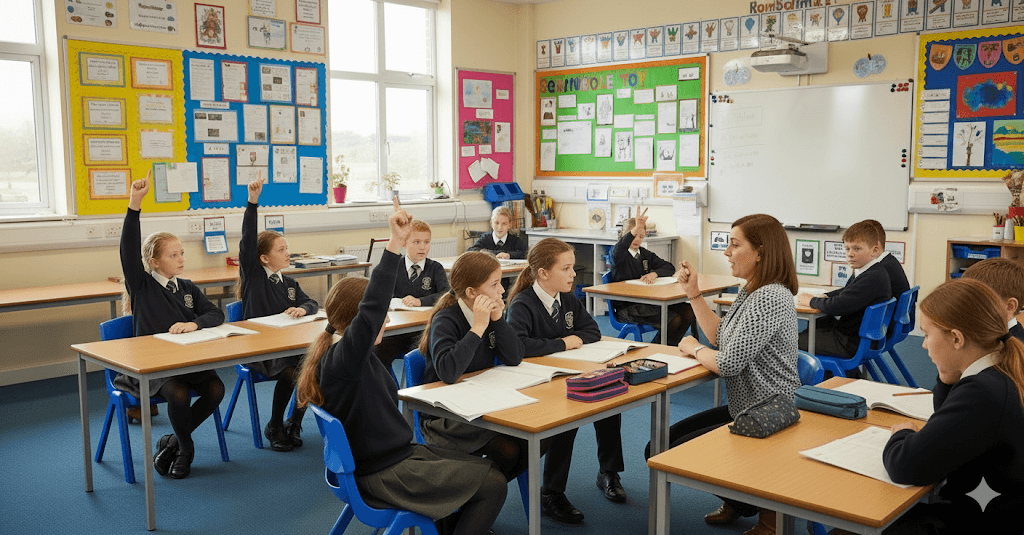

Master lesson plenaries with evidence-based strategies. Learn how to design effective closing activities that consolidate learning and boost retention.
A lesson plenary serves as the reflective bridge between what students have learned and what they'll carry forward. This structured closing segment transforms the final minutes of teaching into a powerful opportunity for consolidation, assessment, and metacognitive development. For teachers seeking to strengthen their practice, understanding how to craft purposeful plenaries can significantly enhance student retention and comprehension.
Key Takeaways:
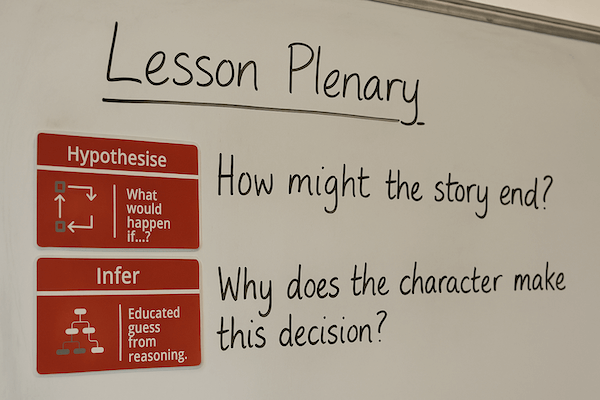
A lesson plenary is the structured closing phase of teaching where students consolidate their learning through guided reflection and application. Unlike a simple recap, plenaries actively engage learners in processing new knowledge, identifying connections, and articulating their understanding. This deliberate pause for reflection serves multiple pedagogical purposes: checking comprehension, addressing misconceptions, and preparing students for future learning.
The term "plenary" derives from the Latin plenus, meaning full or complete. In educational contexts, it represents the completion of the learning cycle within a lesson. Plenaries typically occupy the final 5-10 minutes of class time, though mini-plenaries can be embedded throughout longer sessions to maintain engagement and monitor progress.
Modern plenaries have evolved beyond teacher-led summaries. They now incorporate diverse questioning techniques, peer assessment, and technology-enhanced responses. This shift reflects our growing understanding of how metacognition and self-regulated learning contribute to deeper understanding.

Cognitive science reveals that learning involves two distinct processes: encoding information into memory (storage strength) and accessing it when needed (retrieval strength). Plenaries strengthen both dimensions. When students actively recall and articulate their learning during a plenary, they engage in retrieval practice, which research consistently shows improves long-term retention more effectively than passive review.
The act of summarising, explaining, or applying new knowledge during a plenary forces students to reconstruct their understanding rather than simply recognise familiar content. This reconstructive process identifies gaps, strengthens neural pathways, and creates more robust memory traces.
Plenaries provide structured opportunities for developing student metacognition. When students reflect on what they've learned, how they learned it, and what remains unclear, they develop crucial self-monitoring skills. This metacognitive awareness helps learners become more strategic and independent in their approach to future challenges.
Regular plenary activities teach students to evaluate their own understanding, recognise patterns in their learning, and identify effective strategies. Over time, these reflective habits transfer beyond individual lessons to support lifelong learning.
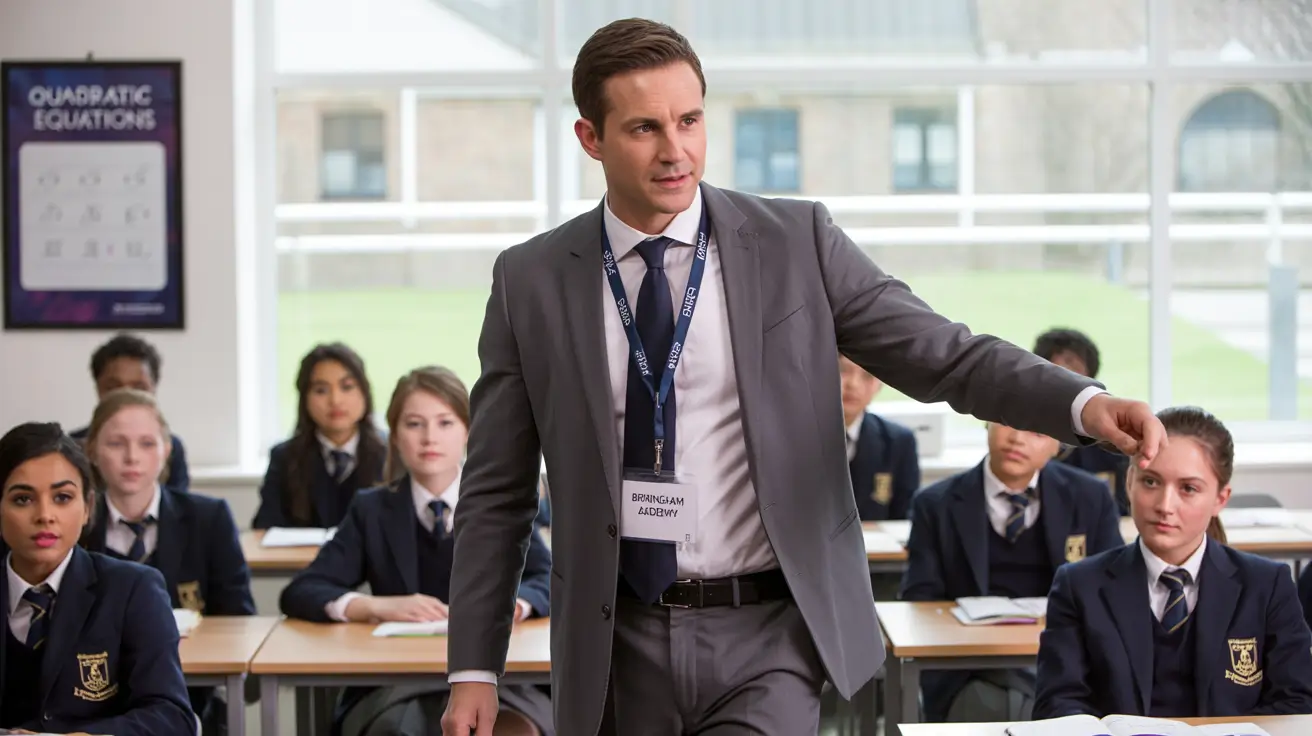
Exit tickets remain one of the most versatile plenary tools. These brief written responses—typically answering one or two focused questions—provide immediate feedback on student understanding whilst requiring minimal preparation. Digital alternatives like Socrative or Mentimeter add engagement through real-time polling and word clouds.
Traffic light cards offer instant visual feedback: green for confidence, amber for partial understanding, red for confusion. This simple system helps teachers gauge whole-class comprehension at a glance whilst encouraging honest self-assessment from students.
The "3-2-1" format structures reflection efficiently: three things learned, two questions remaining, one connection to prior knowledge. This framework balances consolidation with forward-looking curiosity.
Think-pair-share activities transform individual reflection into collaborative learning. Students first process their thoughts independently, then refine their understanding through peer discussion before sharing with the class. This progression supports learners at different confidence levels whilst exposing them to alternative perspectives.
Peer teaching plenaries leverage the "protégé effect"—the phenomenon where explaining to others deepens one's own understanding. Students might create 30-second summaries for a partner or prepare mini-presentations on key concepts.
Gallery walks turn the classroom into an exhibition space where students circulate to view and discuss each other's work, adding sticky-note comments or questions. This movement-based approach maintains energy whilst promoting deeper learning through peer feedback.
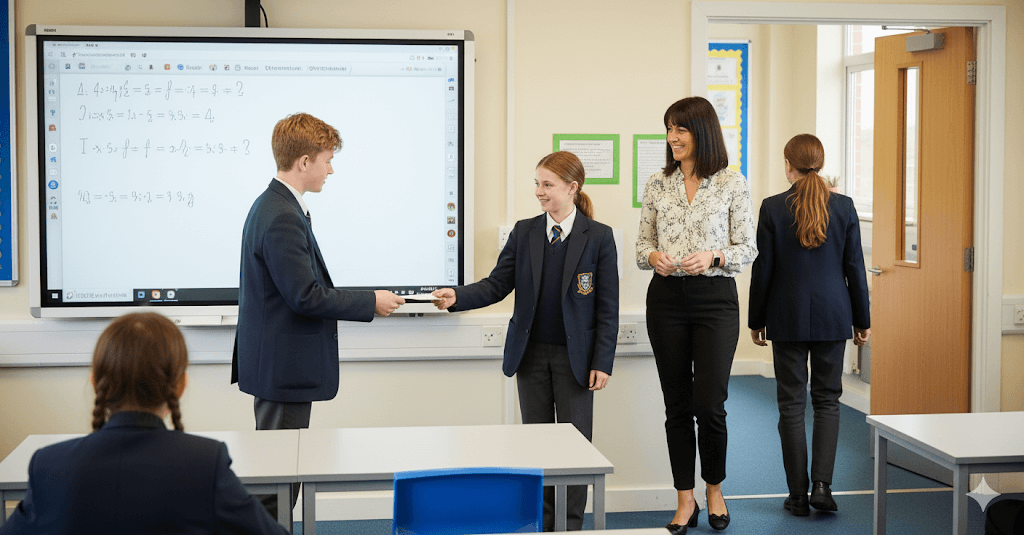
Concept mapping plenaries challenge students to visualise connections between ideas learned during the lesson. These visual representations reveal understanding that might not emerge through verbal questioning alone. Digital tools like Padlet enable collaborative mind-mapping in real-time.
One-minute challenges inject urgency and focus. Students might write headlines summarising the lesson, create analogies explaining key concepts, or draft text messages teaching the content to an absent friend. These creative constraints force essential thinking about what matters most.
The "paper plane" plenary combines movement with assessment. Students write questions or key learnings on paper, fold them into planes, and launch them across the room. Recipients answer the questions or build upon the ideas before returning them. This playful approach maintains engagement whilst ensuring active participation.
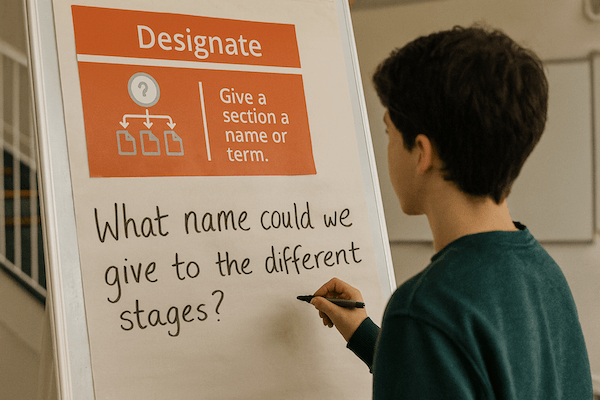
Mini-plenaries punctuate longer lessons with moments of consolidation and redirection. Unlike end-of-lesson plenaries, these brief interludes—typically 2-3 minutes—maintain momentum whilst checking understanding. Research on spaced practice suggests that distributing reflection throughout learning enhances retention more than massed practice at the lesson's end.
Optimal timing depends on lesson structure and student needs. After introducing complex concepts, a mini-plenary helps students process before moving forward. Following group work, brief whole-class sharing consolidates diverse discoveries. Before transitions between topics, quick reviews create cognitive bridges.
Mini-plenaries enable responsive teaching by providing ongoing assessment data. When misconceptions surface during these check-ins, teachers can address them immediately rather than allowing errors to compound. This agility transforms potential learning obstacles into teachable moments.
Joyce-Gibbons's (2017) research highlighted how teachers use spontaneous mini-plenaries to scaffold small-group collaboration. These interventions clarify tasks, refocus attention, and model thinking processes without disrupting workflow entirely.
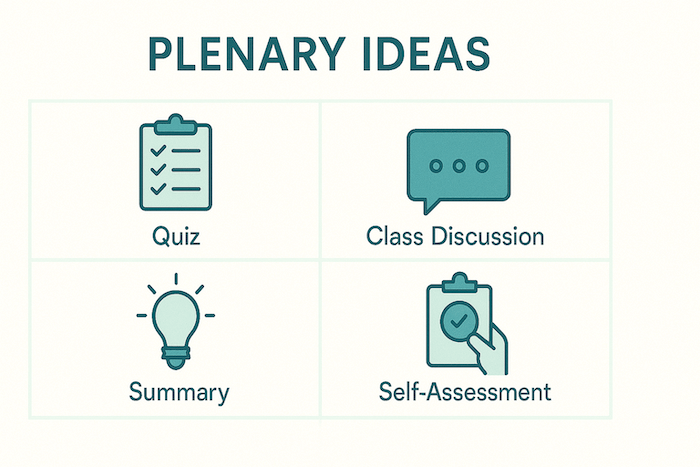
The most frequent concern about plenaries involves time pressure. Teachers worry about "covering content" at the expense of reflection. Yet research consistently shows that lessons incorporating regular consolidation achieve better learning outcomes than those prioritising coverage alone.
Solution: Protect plenary time by building it into lesson planning from the start. Set visible timers to maintain pace. Prepare plenary materials in advance to avoid last-minute scrambling.
Some students resist plenary participation, particularly when activities feel repetitive or disconnected from learning goals. Adolescents especially may perceive reflection activities as childish or unnecessary.
Solution: Vary plenary formats to maintain novelty. Connect activities explicitly to assessment criteria so students understand their purpose. Use technology strategically to increase engagement without sacrificing depth.
Plenaries must accommodate diverse learning needs within limited time. Some students require more processing time whilst others finish quickly and disengage.
Solution: Design tiered plenary tasks with extension options. Provide sentence starters for struggling students whilst challenging advanced learners with synthesis questions. Use collaborative formats where mixed-ability pairs support mutual learning.
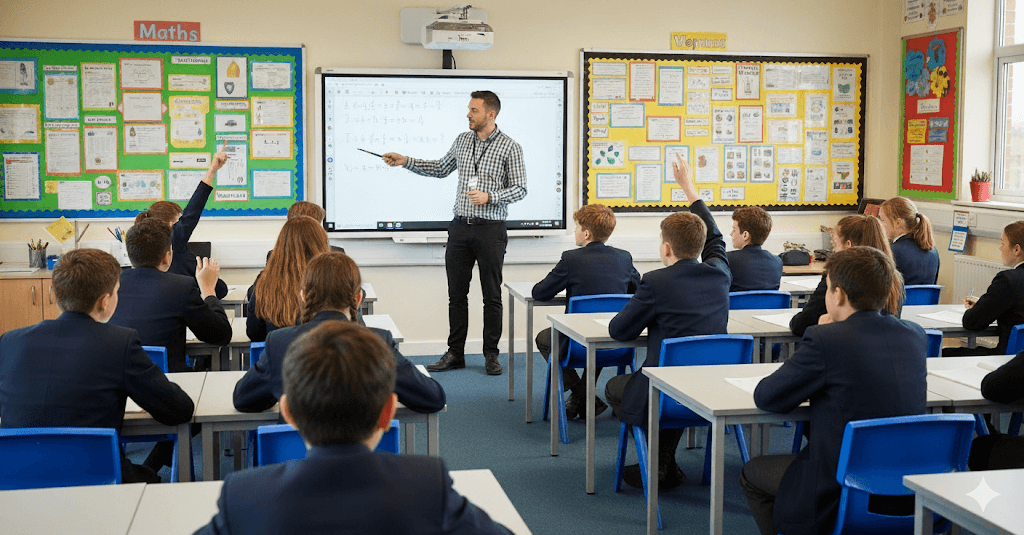
Using the Plenary to Develop Reflective and Critical Thinking – Lawton (2004) This study of mathematics student teachers found that reflection-focused plenaries improved teaching confidence and responsiveness. Teachers who used plenaries to encourage critical thinking reported better classroom dynamics and student participation, particularly in primary settings.
Talk Factory: Supporting Exploratory Talk in Science Plenaries – Kerawalla, Petrou & Scanlon (2013) Interactive whiteboard technology transformed traditional plenaries into collaborative reasoning sessions. Students moved from passive responding to active knowledge construction when teachers facilitated structured exploratory talk during plenaries.
Teachers' Initiation of Mini-Plenaries to Scaffold Small-Group Collaboration – Joyce-Gibbons (2017) Analysis of spontaneous mini-plenaries revealed their scaffolding function in group work. These targeted interruptions clarified misunderstandings, refocused tasks, and promoted self-regulated learning more effectively than end-of-lesson summaries alone.
Bridging Theoretical Knowledge with Classroom Practices – Akhter & Salamat (2025) Trainee teachers who used structured plenaries to link theory with practice showed improved teaching efficacy. Plenaries that connected learning objectives with real-world applications strengthened both understanding and retention.
Effective Teachers in Primary Schools – Siraj‐Blatchford et al. (2013) The EPPSE project identified regular, purposeful plenaries as a hallmark of outstanding pedagogy. Teachers who embedded plenaries achieved stronger pupil engagement and academic progress through consistent consolidation and misconception correction.
Q: How long should a plenary last?A: Typical end-of-lesson plenaries run 5-10 minutes, whilst mini-plenaries work best at 2-3 minutes. The key is maintaining focus and purpose rather than filling time. Match duration to activity complexity and available class time.
Q: Should every lesson have a plenary?A: Whilst not mandatory, regular plenaries strengthen learning consolidation and provide valuable assessment data. Even brief reflection moments offer benefits. Consider your learning objectives and student needs when deciding on plenary inclusion and format.
Q: How do I make plenaries work with challenging classes?A: Structure and routine help establish plenary expectations. Start with simple, highly structured activities before progressing to more open-ended formats. Use behaviour management strategies consistently. Consider movement-based or technology-enhanced options for maintaining engagement.
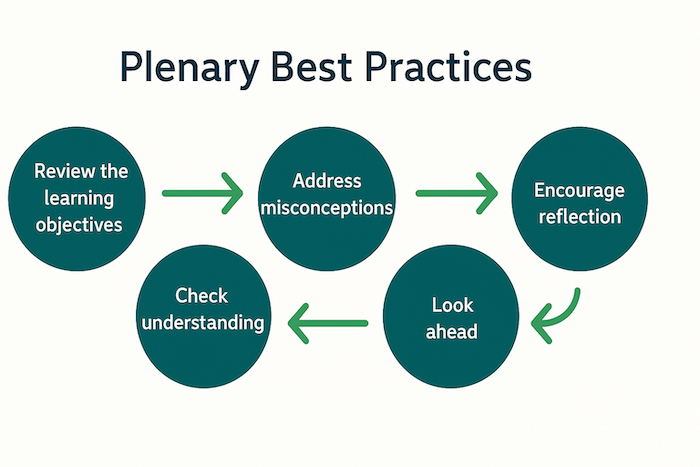
References
Akhter & Salamat (2025). Bridging Theoretical Knowledge with Classroom Practices: Effectiveness of Teaching Practicum for Prospective Teachers.
Joyce-Gibbons, A. (2017). Observe, Interact and Act: Teachers' Initiation of Mini-Plenaries to Scaffold Small-Group Collaboration.
Kerawalla, L., Petrou, M., & Scanlon, E. (2013). Talk Factory: Supporting Exploratory Talk Around an Interactive Whiteboard in Primary School Science Plenaries.
Lawton, F. (2004). Using the Plenary to Develop Reflective and Critical Thinking and to Enhance Metacognitive Awareness.
Siraj‐Blatchford, I., Taggart, B., Sammons, P., Melhuish, E., & Sylva, K. (2013). Effective Teachers in Primary Schools: Key Research on Pedagogy and Children's Learning.
A lesson plenary serves as the reflective bridge between what students have learned and what they'll carry forward. This structured closing segment transforms the final minutes of teaching into a powerful opportunity for consolidation, assessment, and metacognitive development. For teachers seeking to strengthen their practice, understanding how to craft purposeful plenaries can significantly enhance student retention and comprehension.
Key Takeaways:

A lesson plenary is the structured closing phase of teaching where students consolidate their learning through guided reflection and application. Unlike a simple recap, plenaries actively engage learners in processing new knowledge, identifying connections, and articulating their understanding. This deliberate pause for reflection serves multiple pedagogical purposes: checking comprehension, addressing misconceptions, and preparing students for future learning.
The term "plenary" derives from the Latin plenus, meaning full or complete. In educational contexts, it represents the completion of the learning cycle within a lesson. Plenaries typically occupy the final 5-10 minutes of class time, though mini-plenaries can be embedded throughout longer sessions to maintain engagement and monitor progress.
Modern plenaries have evolved beyond teacher-led summaries. They now incorporate diverse questioning techniques, peer assessment, and technology-enhanced responses. This shift reflects our growing understanding of how metacognition and self-regulated learning contribute to deeper understanding.

Cognitive science reveals that learning involves two distinct processes: encoding information into memory (storage strength) and accessing it when needed (retrieval strength). Plenaries strengthen both dimensions. When students actively recall and articulate their learning during a plenary, they engage in retrieval practice, which research consistently shows improves long-term retention more effectively than passive review.
The act of summarising, explaining, or applying new knowledge during a plenary forces students to reconstruct their understanding rather than simply recognise familiar content. This reconstructive process identifies gaps, strengthens neural pathways, and creates more robust memory traces.
Plenaries provide structured opportunities for developing student metacognition. When students reflect on what they've learned, how they learned it, and what remains unclear, they develop crucial self-monitoring skills. This metacognitive awareness helps learners become more strategic and independent in their approach to future challenges.
Regular plenary activities teach students to evaluate their own understanding, recognise patterns in their learning, and identify effective strategies. Over time, these reflective habits transfer beyond individual lessons to support lifelong learning.

Exit tickets remain one of the most versatile plenary tools. These brief written responses—typically answering one or two focused questions—provide immediate feedback on student understanding whilst requiring minimal preparation. Digital alternatives like Socrative or Mentimeter add engagement through real-time polling and word clouds.
Traffic light cards offer instant visual feedback: green for confidence, amber for partial understanding, red for confusion. This simple system helps teachers gauge whole-class comprehension at a glance whilst encouraging honest self-assessment from students.
The "3-2-1" format structures reflection efficiently: three things learned, two questions remaining, one connection to prior knowledge. This framework balances consolidation with forward-looking curiosity.
Think-pair-share activities transform individual reflection into collaborative learning. Students first process their thoughts independently, then refine their understanding through peer discussion before sharing with the class. This progression supports learners at different confidence levels whilst exposing them to alternative perspectives.
Peer teaching plenaries leverage the "protégé effect"—the phenomenon where explaining to others deepens one's own understanding. Students might create 30-second summaries for a partner or prepare mini-presentations on key concepts.
Gallery walks turn the classroom into an exhibition space where students circulate to view and discuss each other's work, adding sticky-note comments or questions. This movement-based approach maintains energy whilst promoting deeper learning through peer feedback.

Concept mapping plenaries challenge students to visualise connections between ideas learned during the lesson. These visual representations reveal understanding that might not emerge through verbal questioning alone. Digital tools like Padlet enable collaborative mind-mapping in real-time.
One-minute challenges inject urgency and focus. Students might write headlines summarising the lesson, create analogies explaining key concepts, or draft text messages teaching the content to an absent friend. These creative constraints force essential thinking about what matters most.
The "paper plane" plenary combines movement with assessment. Students write questions or key learnings on paper, fold them into planes, and launch them across the room. Recipients answer the questions or build upon the ideas before returning them. This playful approach maintains engagement whilst ensuring active participation.

Mini-plenaries punctuate longer lessons with moments of consolidation and redirection. Unlike end-of-lesson plenaries, these brief interludes—typically 2-3 minutes—maintain momentum whilst checking understanding. Research on spaced practice suggests that distributing reflection throughout learning enhances retention more than massed practice at the lesson's end.
Optimal timing depends on lesson structure and student needs. After introducing complex concepts, a mini-plenary helps students process before moving forward. Following group work, brief whole-class sharing consolidates diverse discoveries. Before transitions between topics, quick reviews create cognitive bridges.
Mini-plenaries enable responsive teaching by providing ongoing assessment data. When misconceptions surface during these check-ins, teachers can address them immediately rather than allowing errors to compound. This agility transforms potential learning obstacles into teachable moments.
Joyce-Gibbons's (2017) research highlighted how teachers use spontaneous mini-plenaries to scaffold small-group collaboration. These interventions clarify tasks, refocus attention, and model thinking processes without disrupting workflow entirely.

The most frequent concern about plenaries involves time pressure. Teachers worry about "covering content" at the expense of reflection. Yet research consistently shows that lessons incorporating regular consolidation achieve better learning outcomes than those prioritising coverage alone.
Solution: Protect plenary time by building it into lesson planning from the start. Set visible timers to maintain pace. Prepare plenary materials in advance to avoid last-minute scrambling.
Some students resist plenary participation, particularly when activities feel repetitive or disconnected from learning goals. Adolescents especially may perceive reflection activities as childish or unnecessary.
Solution: Vary plenary formats to maintain novelty. Connect activities explicitly to assessment criteria so students understand their purpose. Use technology strategically to increase engagement without sacrificing depth.
Plenaries must accommodate diverse learning needs within limited time. Some students require more processing time whilst others finish quickly and disengage.
Solution: Design tiered plenary tasks with extension options. Provide sentence starters for struggling students whilst challenging advanced learners with synthesis questions. Use collaborative formats where mixed-ability pairs support mutual learning.

Using the Plenary to Develop Reflective and Critical Thinking – Lawton (2004) This study of mathematics student teachers found that reflection-focused plenaries improved teaching confidence and responsiveness. Teachers who used plenaries to encourage critical thinking reported better classroom dynamics and student participation, particularly in primary settings.
Talk Factory: Supporting Exploratory Talk in Science Plenaries – Kerawalla, Petrou & Scanlon (2013) Interactive whiteboard technology transformed traditional plenaries into collaborative reasoning sessions. Students moved from passive responding to active knowledge construction when teachers facilitated structured exploratory talk during plenaries.
Teachers' Initiation of Mini-Plenaries to Scaffold Small-Group Collaboration – Joyce-Gibbons (2017) Analysis of spontaneous mini-plenaries revealed their scaffolding function in group work. These targeted interruptions clarified misunderstandings, refocused tasks, and promoted self-regulated learning more effectively than end-of-lesson summaries alone.
Bridging Theoretical Knowledge with Classroom Practices – Akhter & Salamat (2025) Trainee teachers who used structured plenaries to link theory with practice showed improved teaching efficacy. Plenaries that connected learning objectives with real-world applications strengthened both understanding and retention.
Effective Teachers in Primary Schools – Siraj‐Blatchford et al. (2013) The EPPSE project identified regular, purposeful plenaries as a hallmark of outstanding pedagogy. Teachers who embedded plenaries achieved stronger pupil engagement and academic progress through consistent consolidation and misconception correction.
Q: How long should a plenary last?A: Typical end-of-lesson plenaries run 5-10 minutes, whilst mini-plenaries work best at 2-3 minutes. The key is maintaining focus and purpose rather than filling time. Match duration to activity complexity and available class time.
Q: Should every lesson have a plenary?A: Whilst not mandatory, regular plenaries strengthen learning consolidation and provide valuable assessment data. Even brief reflection moments offer benefits. Consider your learning objectives and student needs when deciding on plenary inclusion and format.
Q: How do I make plenaries work with challenging classes?A: Structure and routine help establish plenary expectations. Start with simple, highly structured activities before progressing to more open-ended formats. Use behaviour management strategies consistently. Consider movement-based or technology-enhanced options for maintaining engagement.

References
Akhter & Salamat (2025). Bridging Theoretical Knowledge with Classroom Practices: Effectiveness of Teaching Practicum for Prospective Teachers.
Joyce-Gibbons, A. (2017). Observe, Interact and Act: Teachers' Initiation of Mini-Plenaries to Scaffold Small-Group Collaboration.
Kerawalla, L., Petrou, M., & Scanlon, E. (2013). Talk Factory: Supporting Exploratory Talk Around an Interactive Whiteboard in Primary School Science Plenaries.
Lawton, F. (2004). Using the Plenary to Develop Reflective and Critical Thinking and to Enhance Metacognitive Awareness.
Siraj‐Blatchford, I., Taggart, B., Sammons, P., Melhuish, E., & Sylva, K. (2013). Effective Teachers in Primary Schools: Key Research on Pedagogy and Children's Learning.